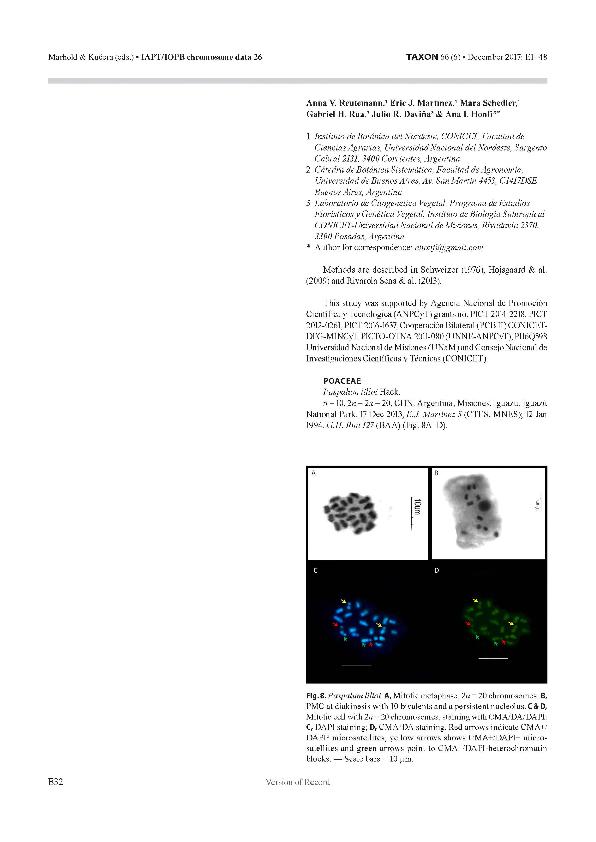Artículo
POACEAE. Paspalum lilloi Hack.
Reutemann, Anna Verena ; Martínez, Eric Javier
; Martínez, Eric Javier ; Schedler, Mara
; Schedler, Mara ; Rua, Gabriel Hugo
; Rua, Gabriel Hugo ; Daviña, Julio Rubén; Honfi, Ana Isabel
; Daviña, Julio Rubén; Honfi, Ana Isabel
 ; Martínez, Eric Javier
; Martínez, Eric Javier ; Schedler, Mara
; Schedler, Mara ; Rua, Gabriel Hugo
; Rua, Gabriel Hugo ; Daviña, Julio Rubén; Honfi, Ana Isabel
; Daviña, Julio Rubén; Honfi, Ana Isabel
Fecha de publicación:
12/2017
Editorial:
International Association for Plant Taxonomy
Revista:
Taxon
ISSN:
0040-0262
e-ISSN:
1996-8175
Idioma:
Inglés
Tipo de recurso:
Artículo publicado
Clasificación temática:
Resumen
Paspalum lilloi Hack. is an endemic species from Iguazú Falls. Karyomorphometric analyses and meiotic behaviour description are presented for the first time for the species. It showed unimodal and symmetrical karyotype (1A according to Stebbins’s categories, 1971), comprising 20 metacentric chromosomes (Fig. 8A) whose length is ranging from 2.8 to 1.6 μm, and 22.69 μm per haploid genome. Chromosomes behave regularly at meiosis, with mainly 20II at diakinesis and also 9II + 2I, 8II + 4I, 7II + 6I, 6II + 8I (Fig. 8B). At diakinesis and metaphase I, the mean frequency of I was 3.085 ± 0.358 per pollen mother cell (PMC) and 8.457 ± 0.209 II per PMC. Tri-staining with CMA/Distamycin-A/DAPI fluorochromes revealed the presence of two pairs of bands localized on two microsatellites, in pair 3 and 9, respectively. Chromosomes were arranged, according to the total chromosome length. The microsatellite of the short arm on pair 3 was GC- rich (CMA+/DAPI0), and a GC-rich (CMA+) terminal band on the long arm of these chromosomes was detected. The pair 9 showed an AT-rich band as well as a GC-rich (CMA+/DAPI+) microsatellites, both localized on the short arm (Fig. 8C, D). Karyotype, and heterochromatin pattern are presented for the first time for the species
Palabras clave:
Endemic Species
,
Heterochromatin Pattern
,
Karyotype
,
Meiosis
Archivos asociados
Licencia
Identificadores
Colecciones
Articulos(IBONE)
Articulos de INST.DE BOTANICA DEL NORDESTE (I)
Articulos de INST.DE BOTANICA DEL NORDESTE (I)
Citación
Reutemann, Anna Verena; Martínez, Eric Javier; Schedler, Mara; Rua, Gabriel Hugo; Daviña, Julio Rubén; et al.; POACEAE. Paspalum lilloi Hack.; International Association for Plant Taxonomy; Taxon; 66; 6; 12-2017; 1487-1499
Compartir



